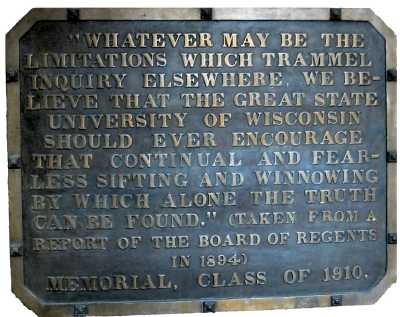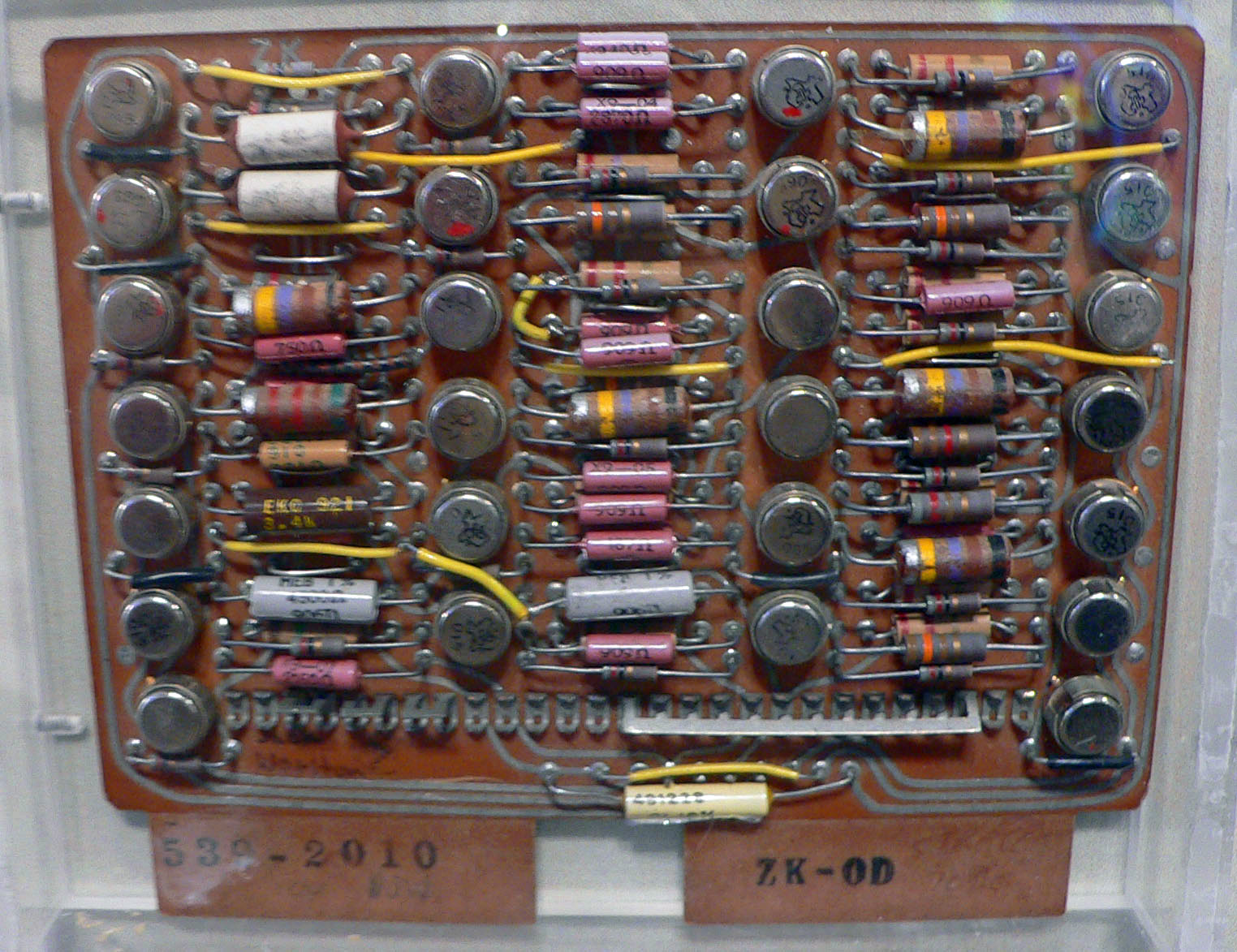|
Wisconsin Integrally Synchronized Computer
The Wisconsin Integrally Synchronized Computer (WISC) was an early digital computer designed and built at the University of Wisconsin–Madison. Operational in 1954, it was the first digital computer in the state. Pioneering computer designer Gene Amdahl drafted the WISC's design as his PhD thesis. The computer was built over the period 1951-1954. It had 1,024 50-bit words (equivalent to about 6 KB) of drum memory, with an operation time of 1/15 second and throughput of 60 operations per second, which was achieved by an early form of instruction pipeline. It was capable of both fixed and floating point operation. It weighed about . The WISC is part of the permanent collection of the Computer History Museum. References External linksOral history interview with Gene M. Amdahl.Charles Babbage Institute, University of Minnesota, Minneapolis. Amdahl starts by describing his early life and education, recalling his experiences teaching in the Advanced Specialized Training Program dur ... [...More Info...] [...Related Items...] OR: [Wikipedia] [Google] [Baidu] |
University Of Wisconsin–Madison
The University of Wisconsin–Madison (University of Wisconsin, Wisconsin, UW, UW–Madison, or simply Madison) is a public land-grant research university in Madison, Wisconsin, United States. It was founded in 1848 when Wisconsin achieved statehood and is the flagship campus of the University of Wisconsin System. The main campus is located on the shores of Lake Mendota; the university also owns and operates a arboretum south of the main campus. UW–Madison is organized into 13 schools and colleges, which enrolled approximately 34,200 undergraduate and 14,300 graduate and professional students in 2024. Its academic programs include 136 undergraduate majors, 148 master's degree programs, and 120 doctoral programs. Wisconsin is one of the founding members of the Association of American Universities. It is considered a Public Ivy and is classified as an R1 University. UW–Madison was also the home of both the prominent "Wisconsin School" of economics and diplomatic h ... [...More Info...] [...Related Items...] OR: [Wikipedia] [Google] [Baidu] |
Gene Amdahl
Gene Myron Amdahl (November 16, 1922 – November 10, 2015) was an American computer architect and high-tech entrepreneur, chiefly known for his work on mainframe computers at IBM and later his own companies, especially Amdahl Corporation. He formulated Amdahl's law, which states a fundamental limitation of parallel computing. Childhood and education Amdahl was born to immigrant parents of Norwegian and Swedish descent in Flandreau, South Dakota. After serving in the Navy during World War II he completed a degree in engineering physics at South Dakota State University in 1948. He went on to study theoretical physics at the University of Wisconsin–Madison under Robert G. Sachs. However, in 1950, Amdahl and Charles H. "Charlie" Davidson, a fellow PhD student in the Department of Physics, approached Prof. Harold A. Peterson with the idea of a digital computer. Amdahl and Davidson gained the support of Peterson and fellow electrical engineering professor Vincent C. Rideo ... [...More Info...] [...Related Items...] OR: [Wikipedia] [Google] [Baidu] |
Drum Memory
Drum memory was a magnetic data storage device invented by Gustav Tauschek in 1932 in Austria. Drums were widely used in the 1950s and into the 1960s as computer memory. Many early computers, called drum computers or drum machines, used drum memory as the main working memory of the computer. Some drums were also used as Auxiliary memory, secondary storage as for example various IBM_drum_storage, IBM drum storage drives and the UNIVAC FASTRAND series of drums. Drums were displaced as primary computer memory by magnetic core memory, which offered a better balance of size, speed, cost, reliability and potential for further improvements. Drums were then replaced by hard disk drives for secondary storage, which were both less expensive and offered denser storage. The manufacturing of drums ceased in the 1970s. Technical design A drum memory or drum storage unit contained a large metal cylinder, coated on the outside surface with a ferromagnetic recording material. It could be ... [...More Info...] [...Related Items...] OR: [Wikipedia] [Google] [Baidu] |
Instruction Pipeline
In computer engineering, instruction pipelining is a technique for implementing instruction-level parallelism within a single processor. Pipelining attempts to keep every part of the processor busy with some instruction by dividing incoming Machine code, instructions into a series of sequential steps (the eponymous "Pipeline (computing), pipeline") performed by different Central processing unit#Structure and implementation, processor units with different parts of instructions processed in parallel. Concept and motivation In a pipelined computer, instructions flow through the central processing unit (CPU) in stages. For example, it might have one stage for each step of the von Neumann architecture, von Neumann cycle: Fetch the instruction, fetch the operands, do the instruction, write the results. A pipelined computer usually has "pipeline registers" after each stage. These store information from the instruction and calculations so that the logic gates of the next stage can do th ... [...More Info...] [...Related Items...] OR: [Wikipedia] [Google] [Baidu] |
Floating Point
In computing, floating-point arithmetic (FP) is arithmetic on subsets of real numbers formed by a ''significand'' (a signed sequence of a fixed number of digits in some base) multiplied by an integer power of that base. Numbers of this form are called floating-point numbers. For example, the number 2469/200 is a floating-point number in base ten with five digits: 2469/200 = 12.345 = \! \underbrace_\text \! \times \! \underbrace_\text\!\!\!\!\!\!\!\overbrace^ However, 7716/625 = 12.3456 is not a floating-point number in base ten with five digits—it needs six digits. The nearest floating-point number with only five digits is 12.346. And 1/3 = 0.3333… is not a floating-point number in base ten with any finite number of digits. In practice, most floating-point systems use base two, though base ten (decimal floating point) is also common. Floating-point arithmetic operations, such as addition and division, approximate the corresponding real number arithmetic operations ... [...More Info...] [...Related Items...] OR: [Wikipedia] [Google] [Baidu] |
Computer History Museum
The Computer History Museum (CHM) is a computer museum in Mountain View, California. The museum presents stories and artifacts of Silicon Valley and the Information Age, and explores the Digital Revolution, computing revolution and its impact on society. History The museum's origins date to 1968 when Gordon Bell began a quest for a historical collection and, at that same time, others were looking to preserve the Whirlwind (computer), Whirlwind computer. The resulting ''Museum Project'' had its first exhibit in 1975, located in a converted coat closet in a Digital Equipment Corporation, DEC lobby. In 1978, the museum, now ''The Digital Computer Museum'' (TDCM), moved to a larger DEC lobby in Marlborough, Massachusetts and opened to the public in September 1979. Maurice Wilkes presented the first lecture at TDCM in 1979 – the presentation of such lectures has continued to the present time. TDCM incorporated as ''The Computer Museum, Boston, The Computer Museum'' (TCM) in 1982. ... [...More Info...] [...Related Items...] OR: [Wikipedia] [Google] [Baidu] |
Charles Babbage Institute
The IT History Society (ITHS) is an organization that supports the history and scholarship of information technology by encouraging, fostering, and facilitating archival and historical research. Formerly known as the Charles Babbage Foundation, it advises historians, promotes collaboration among academic organizations and museums, and assists IT corporations in preparing and archiving their histories for future studies. Activities The IT History Society provides background information to those with an interest in the history of Information Technology, including papers that provide advice on how to perform historical work and how historical activities can benefit private sector organizations. It tracks historical projects seeking funding as well as projects underway and completed. It maintains online, publicly available, lists of events pertaining to IT history, IT history resources, an IT Honor Roll acknowledging more than 700 individuals who have made a noteworthy contribution ... [...More Info...] [...Related Items...] OR: [Wikipedia] [Google] [Baidu] |
IBM 7030 Stretch
The IBM 7030, also known as Stretch, was IBM's first transistorized supercomputer. It was the fastest computer in the world from 1961 until the first CDC 6600 became operational in 1964."Designed by Seymour Cray, the CDC 6600 was almost three times faster than the next fastest machine of its day, the IBM 7030 Stretch." Originally designed to meet a requirement formulated by Edward Teller at Lawrence Livermore National Laboratory, the first example was delivered to Los Alamos National Laboratory in 1961, and a second customized version, the IBM 7950 Harvest, to the National Security Agency in 1962. The Stretch at the Atomic Weapons Research Establishment at Aldermaston, England was heavily used by researchers there and at AERE Harwell, but only after the development of the S2 Fortran compiler which was the first to add dynamic arrays, and which was later ported to the Ferranti Atlas of Atlas Computer Laboratory at Chilton. The 7030 was much slower than expected and failed t ... [...More Info...] [...Related Items...] OR: [Wikipedia] [Google] [Baidu] |
IBM 701
The IBM 701 Electronic Data Processing Machine, known as the Defense Calculator while in development, was IBM’s first commercial scientific computer and its first series production mainframe computer, which was announced to the public on May 21, 1952. It was designed and developed by Jerrier Haddad and Nathaniel Rochester and was based on the IAS machine at Princeton. The IBM 701 was the first computer in the IBM 700/7000 series, which were IBM’s high-end computers until the arrival of the IBM System/360 in 1964. The business-oriented sibling of the 701 was the IBM 702 and a lower-cost general-purpose sibling was the IBM 650, which gained fame as the first mass-produced computer. History IBM 701 competed with Remington Rand's UNIVAC 1103 in the scientific computation market. In early 1954, a committee of the Joint Chiefs of Staff requested that the two machines be compared for the purpose of using them for a Joint Numerical Weather Prediction project. Based on the t ... [...More Info...] [...Related Items...] OR: [Wikipedia] [Google] [Baidu] |
IBM 704
The IBM 704 is the model name of a large digital computer, digital mainframe computer introduced by IBM in 1954. Designed by John Backus and Gene Amdahl, it was the first mass-produced computer with hardware for floating-point arithmetic. The IBM 704 ''Manual of operation'' states: The type 704 Electronic Data-Processing Machine is a large-scale, high-speed electronic calculator controlled by an internally stored program of the single address type. The 704 at that time was thus regarded as "pretty much the only computer that could handle complex math". The 704 was a significant improvement over the earlier IBM 701 in terms of architecture and implementation. Like the 701, the 704 used vacuum-tube logic circuitry, but increased the instruction size from 18-bit computing, 18 bits to 36-bit computing, 36 bits, the same as the memory's word size. Changes from the 701 include the use of magnetic-core memory instead of Williams tubes, floating-point arithmetic instructions, 15 ... [...More Info...] [...Related Items...] OR: [Wikipedia] [Google] [Baidu] |
Nathaniel Rochester (computer Scientist)
Nathaniel Rochester (January 14, 1919 – June 8, 2001) was the chief architect of the IBM 701, the first mass produced scientific computer, and of the prototype of its first commercial version, the IBM 702. He wrote the first assembler and participated in the founding of the field of artificial intelligence. Early work Rochester received his B.S. degree in electrical engineering from the Massachusetts Institute of Technology in 1941. He stayed on at MIT in the Radiation Laboratory for three years and then moved to Sylvania Electric Products where he was responsible for the design and construction of radar sets and other military equipment. His group built the arithmetic element for the Whirlwind I computer at MIT. IBM 701 computer In 1948, Rochester moved to IBM, where he co-designed, along with Jerrier Haddad, the first mass-produced scientific computer, the IBM 701. He wrote the first symbolic assembler, which allowed programs to be written in short, readable co ... [...More Info...] [...Related Items...] OR: [Wikipedia] [Google] [Baidu] |





